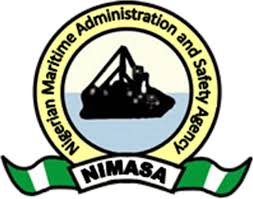
From right: Chairman, House Committee on Maritime Safety, Education and Administration, Hon. Mohammed Umaru Bago, Minister of Transportation, Rt. Hon. Rotimi Amaechi, CON, Chairman, Board of the Nigerian Ports Authority (NPA), Mr. Emmanuel Olajide Adesoye and Director General, Nigerian Maritime Administration and Safety Agency (NIMASA) Dr. Dakuku Peterside during the 2nd edition of the maritime Stakeholders’ interactive forum tagged: “Implementation of Executive Order I (Ease of Doing Business) in a secure maritime environment” held in Warri, Delta State.
The Nigerian Maritime industry is projected to grow by 2.5 – 5 % within the period 2018-2019 and a projected increase in demand for maritime services in Nigeria during the period of projection. This was contained in the Nigerian maritime industry forecast for 2018/2019 unveiled today in Lagos, by Dr. Dakuku Adol Peterside, Director General, Nigerian Maritime Administration and Safety Agency (NIMASA)
The analysis in the publication shows that Nigerians should expect total fleet size to grow by 4.08% in 2018 and 4.41% in 2019. The maritime forecast released by NIMASA also project that oil tanker fleet size will decrease by 2.23% in 2018 and increase by 1.7% in 2019. The non-oil tanker fleet size is projected to increase by 8.15 % in 2018 and 8.72% in 2019 while the oil rig count is projected to increase by 27.67% in 2018 and 0% in 2019.
While noting that the maritime sector plays a major role in the exploitation, distribution and export of Nigeria’s ocean resources. With a total annual freight cost estimated at between $5 and $6 billion dollars annually. The maritime component of the Nigerian oil; & Gas industry is worth an estimated $8 billion dollars further reflecting the prominence of the sector to the Nigerian economy
The Nigerian Maritime Industry Forecast for 2018 and 2019 which is the first of its kind in the sector is intended to serve as a compass for local and international stakeholders willing to do business in the Nigeria maritime domain. It is part of the initiatives of the Dr. Dakuku Peterside led Management aimed at realizing a robust and virile maritime industry in Nigeria. The forecast period 2018-2019 covers a time of continuous recovery from recession, to the 2019 general elections and finally culminates in the post-election era
“As a regulator, we are driven by values and commitment, as these are the only ways that investors can be attracted to harness the great potentials in our maritime sector. On our part, we will continue to work out incentives and maritime sector specific interventions to attract Speaking further at the event, the Director General of NIMASA Dr. Dakuku Peterside expressed delight at the maritime forecast release which coincided with the release of the country’s Gross Domestic Product (GDP) figures by the National Bureau of Statistics (NBS) confirming Nigeria’s exit from recession. He noted that it is a positive indicator that Nigeria’s economy is rebound for growth in 2018 and beyond.
Dr. Peterside said the forecast reviewed developments in the industry in 2017; shows expected International and Local Developments in Policy and Regulatory Environment for the Maritime Sector in 2018 and 2019 and also takes a look at Emerging Opportunities and Challenges for the Maritime Industry; all with the sole aim of realizing a robust and business friendly maritime domain that will also create avenues for economic prosperity. He identified five bills undergoing legislative processes at the national assembly as key regulatory developments in the Nigerian maritime industry that will affect the maritime industry. These include the Anti-Piracy Bill, the establishment of the Maritime Development Bank, Inland Fisheries Amendment Bill, the Deep Offshore and Inland Basin Production Sharing Contract Amendment Bill and the Cabotage Act Amendment Bill 2017. “All these if passed to Law will help realise the dream of making Nigeria the maritime hub in Africa,”
Dr. Peterside who also maintained that despite the fact that the oil sector remains one of the pillars of the Nigerian economy and a catalyst for measuring the nation’s growth, the success of it is still largely dependent on the maritime sector which continues to play a strategic role in the economy of the country. He also pointed out that some other factors that have contributed to the gradual growth being recorded in the sector are the receding crime in the Niger Delta Region, the Deep Blue Economy scale up of our maritime security architecture and continuous collaboration, which is addressing the immediate challenge in this areas aimed at suppressing the emerging threats on our waters.
While unveiling the book that contained the forecast for the industry, Dr. Peterside noted that the outlook is the key parameters that will drive the maritime industry and highlighted some key drivers of the sector as; geographic factor, availability of skilled labour force, an efficient and effective regulatory environment, manpower and human capacity development, maritime infrastructural development, globalization and new technology amongst others.
In a goodwill message at the event, the Secretary General of the Abuja Memorandum of Understanding (MoU) and former DG of NIMASA, Barrister (Mrs.) Mfon Usoro commended the forecast as a great interaction with the industry players to move the sector forward. Furthermore, she also observed that the increased presence of NIMASA activities in the maritime sector of the West and Central Africa sub-region is an indication that the present leadership of the Agency is on course.
Also speaking, Dr. Doyin Salami, a Faculty at the Lagos Business School noted that forecasts are essential tools for growing an industry. In his analysis of the maritime forecast at the event, he pointed out that the gaps in the sector must be filled by policy makers in the sector in order to realize its potentials. He urged all investors, local and international to take the forecast serious as a way of enhancing the growth of their businesses.

